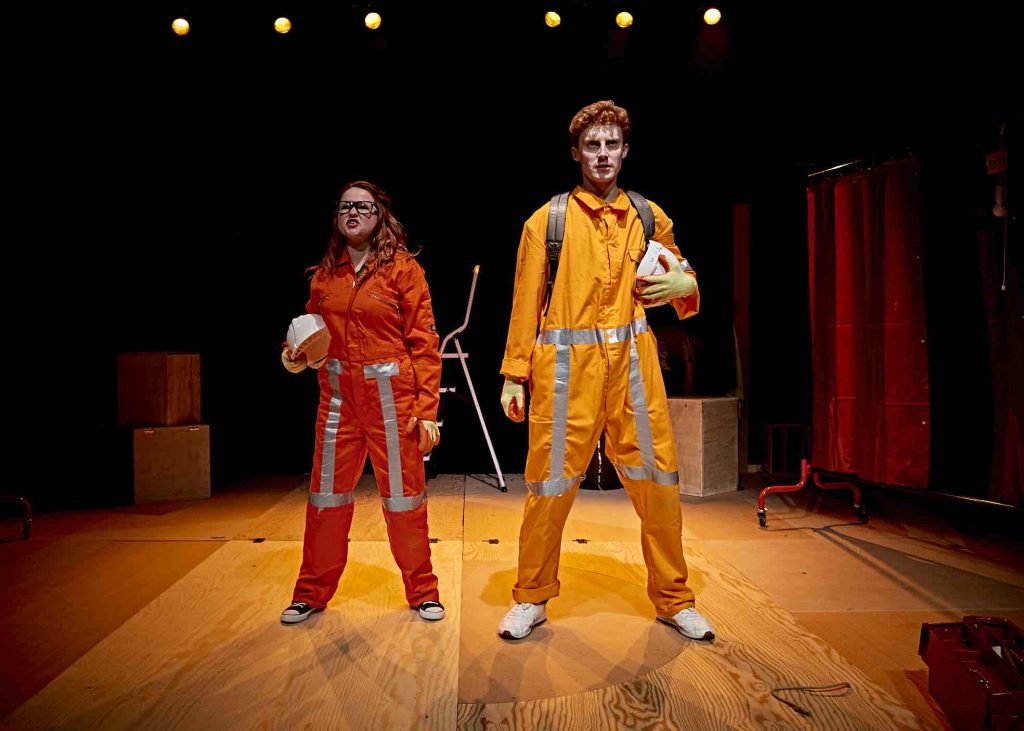The new production by Dirty Protest is a fast-paced, quick-witted piece from the pen of playwright Mark Williams, which cleverly defies the boundaries between genres by managing to be at the same time a lighthearted comedy and a piece of serious drama (rather than a drama with comedic undertones, a typology that has been far too prevalent in theatres in recent years). It also avoids with equal intelligence another and perhaps more formidable obstacle – that is, it is never driven by its subject matter, naturally rife with references to Star Wars, into becoming a nostalgia operation, a risk that is very present in a moment in which nostalgia has in many ways become a franchise of its own. Lightspeed, on the contrary, uses Star Wars as a conduit to link past and present, and as a narrative pretext – clearly beloved, but no less a pretext – to build a story that is made first and foremost of real people, with well-rounded character that easily attract the viewer’s sympathies and understanding.
The script manages to balance its more serious topics, including the management of grief, the conflict between aspirations and financial need in working class families, and the relationship within parents and children, with an equally good comedic pace. This is partly due to the excellent tempo and the convincing performances of its cast, which delivers a number of well-rounded characters while dealing with the task, all but simple, of constantly switching between different personas. In this sense, the piece would perhaps have benefited from a slightly larger cast. While all performances were of excellent standard and all actors made an impressive job of juggling characters very different from each other, the constant switching – multiple times within the same narrative line, in the space of few minutes – sometimes created a slightly jarring effect, quickly compensated by the skill of all cast member, but nonetheless present. In particular, Kieron Self and Jack Hammett, who play adult Sam and young Sam respectively, would have deserved to be able to devote all of their skill to their main character – even though their secondary performances were no less engaging and convincing. Deserving of praise are also the performances of Sian Davies, perhaps one of the most sympathetic figures as Lizzie and no less entertaining as Sarah, and of Dick Bradnum, who achieved the complex feat of outlining a variety of characters along a very wide range of personalities.
Catherine Paskell’s directing work is precise and unobtrusive, and shows in the almost clockwork working of all dramatic times, well complemented by a clever use of light and particularly sound, containing numerous flash backs to the shared imaginary of old-school sci-fi. Sound is never casual in this play, and a number of auditory flash backs help join the past timeline with the present one, providing an exact counterpart to the repetition of core lines by the characters, making sure that the two plotlines intersect smoothly without feeling disjointed. Particularly interesting is the choice of creating a mute interaction between characters belonging to the two different timelines at various points in the play, a rather complex device that is nonetheless executed with elegance and manages to deliver multiple layers of meaning. Without losing the lightness of the text, this silent interplay tells the audience much about the way in which the protagonist looks back on his younger self, as well as the expectations he had as a boy and the disappointments he has suffered.
The set is simple and easily adaptable to represent different situations, as it needs to be with a play that tells a story in two different timelines and a variety of settings, and requires therefore numerous changes of scene. While this device is in most cases effective, there are moments in which movement on the scene is perhaps too frantic, and where the need for a somewhat more structured physical framework is perhaps felt. The erecting of the wooden structure representing the spaceship towards the end, however, contrasts with the sparseness of other fixed set installations in a way that drives home the importance of the moment, and is a very good example of a good construction of narrative meaning through non-verbal means.
The greatest strength of the play is perhaps in its commitment to its main themes, and in the way in which it addresses them – never obvious, never preachy, showing in-depth investigation without offering easy answers. Rather than a simple tale of challenging dreams and parent-child relationships, as it might seem at first sight, Lightspeed reveals itself to be (and makes it clear in its very last line) truly an investigation of the way in which our childhood experiences and our relationships with our parents shape us as adults and deeply influence the kind of parents we ourselves will become. This is perhaps the true core of Sam’s tale, and one might suspect that the repercussions of past actions will reverberate further in the future, also shaping the trajectory of Lizzie’s adulthood. More themes are evoked in lesser depth, but no less convincingly: class struggle is a phantom constantly hovering in the background of a play that, while not being straightforwardly political, never forgets its all-important social context, and there is a beautiful moment in which a grief kept as a subtext throughout the play finally explodes on stage and becamea main propeller for the plot.
All in all, Lightspeed from Pembroke Dock is a clever and ambitious production, that plays on a pop culture anecdote without slipping into nostalgia and constructs a story of human, believable characters, which manage to engage the audience and truly make the viewer invested in their lives. It is a relatable work that tackles complex and challenging themes without losing its tongue-in-cheek sense of humour, and a good example of ways in which cultural references can be used as a baseline for a discourse on the lives we lead and what influences them.
Danille Fahiya review:

